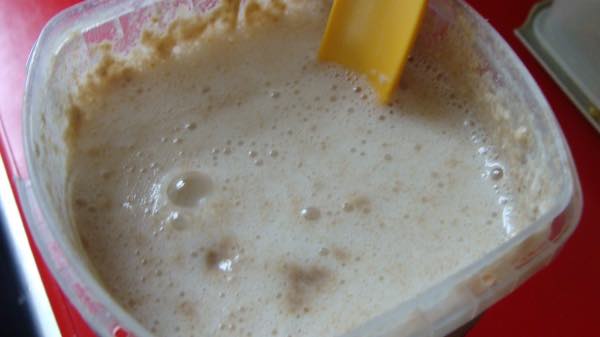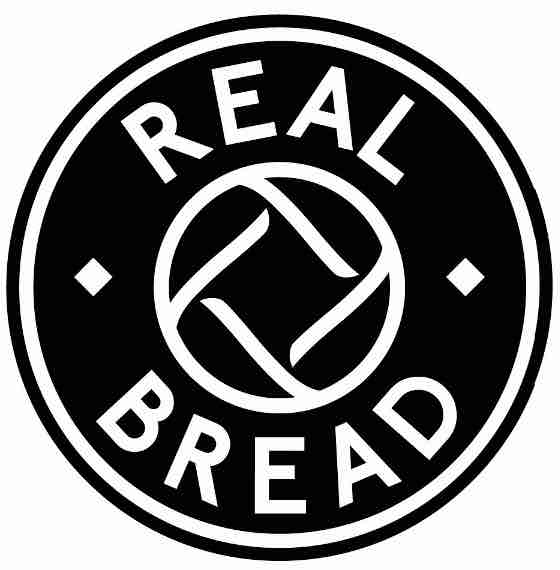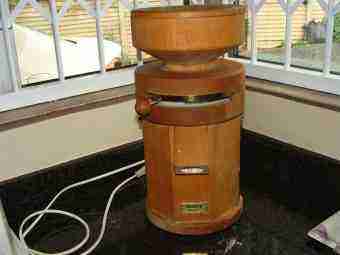- Bernard Preston homepage
- Bread
- Preserving Sourdough Starter
Preserving sourdough starter
Preserving sourdough starter is for those who only bake occasionally.
The sourdough starter really needs to be fed and stirred regularly, otherwise it begins to get an unpleasant-odour; normally it has a delicious fruity scent.
For those who bake less regularly, preserving your sourdough starter may be relevant. Then you will always have some on hand, even though you perhaps haven't made bread for months.
It is interesting that in all five blue zones of the world, where ten-times as many people live to a zestful old age, they eat only sourdough bread. It is refined carbohydrate not whole grains that are the very devil.

- In a bowl, place 1 tsp of active starter. Add a cup of stone-ground flour with enough water to make a paste.
- Heat some water in a pot to around 27oC. Put the bowl in and cover it.
- Or just keep it in a warm spot.
- Keep it warm, and do not overheat. When bubbling actively, spread the starter thinly with a spatula on a plastic bag.
- Place in a warm place, out of the way. It will dehydrate within a few days, unless it is very humid.
- Break the film in small pieces and put it into an airtight-jar.
- To use, take 1 TBSP of the bits of the dehydrated-starter. Add 3 tablespoons of flour and enough water to make a paste; keep it warm.
It takes a bit longer to hydrate and become active but this method eliminates most of the problems.
I confess I haven't actually tried this, but Petra is a seasoned baker, and this is her contribution. It involves spreading your active starter in a thin-sheet, allowing it to dry for a few days, and then keeping it in an airtight jar.
Dough has a mind of its own so bread-experiments are important to consistently produce a loaf that is to your liking. For example, should the addition of salt be delayed or do you dissolve it in the water at the same time as the sourdough starter; or even before? Or you could just toss it in with the other ingredients.
Temperature is incredibly important so do not be afraid to actually use a thermometer to measure that of the water in which you dissolve the salt, and see what the result is. I'm finding cooler is better.
Preserving sourdough starter
Preserving sourdough starter is simple, enabling you to keep the active-agent for when it is needed, but is quite unnecessary for someone who likes fresh bread daily.
Real bread

"Real" bread as it is being called is baked using 100% wholemeal with no separation of the three-streams of bran, germ and endosperm; no chemicals are added to hasten the process.
In commercial mills the three streams are separated, and most of the bran and germ are sold off to other parties; that is where the real value is and we are left with the low-quality carbohydrate.
By international law they only have to replace more than 60% in order to call it wholemeal. These refined-grains, devoid of the protein, oils and fibre are highly glycemic; glucose is rapidly absorbed into the portal system giving a blood sugar surge. It is very fattening.
Remembering that whole grains are very nutritious and good for us[1], we strongly encourage the use of 100% wheatmeal. Bread baked using refined-flour not only tastes dull but it is rapidly digested in the small intestine resulting a massive uptake of glucose by the liver.
If this oversupply of refined carbs to the body continues, these sugars become trapped as triglycerides in the cells causing eventually non-alcoholic fatty-liver disease; ironically it's not caused by lipids from our food.
Since 100% wholemeal is not generally available, you either have to find a local miller, or purchase an electric grinder yourself. Your bread is not only far more nutritious and good for you, but it also tastes a lot better. It has a low glycemic index; it's not fattening. Even so limit yourself to one slice.
This is what is being called real bread; the commercial loaf is a fake.

Now with use of your knowledge of preserving sourdough starter you can have fresh real sourdough-bread at short notice.
When browsing use right click and Open Link in New Tab, or you may get a bad gateway signal.
Newsletter
Our newsletter is entitled "create a cyan zone" at your home, preserving both yourself and Mother Earth for future generations; and the family too, of course. We promise not to spam you with daily emails promoting various products. You may get an occasional nudge to buy one of my books.
Here are the back issues.
- Lifestyle and ideal body weight
- What are ultra-processed foods?
- Investing in long-term health
- Diseases from plastic exposure
- Intensive lifestyle management for obesity has limited value
- A world largely devoid of Parkinson's Disease
- The impact of friendly bacteria in the tum on the prevention of cancer
- There's a hole in the bucket
- Everyone is talking about weight loss drugs
- Pull the sweet tooth
- If you suffer from heartburn plant a susu
- Refined maize meal and stunting
- Should agriculture and industry get priority for water and electricity?
- Nature is calling
- Mill your own flour
- Bake your own sourdough bread
- Microplastics from our water
- Alternative types of water storage
- Wear your clothes out
- Comfort foods
- Create a bee-friendly environment
- Go to bed slightly hungry
- Keep bees
- Blue zone folk are religious
- Reduce plastic waste
- Family is important
- What can go in compost?
- Grow broad beans for longevity
- Harvest and store sunshine
- Blue zone exercise
- Harvest and store your rainwater
- Create a cyan zone at your home
Did you find this page interesting? How about forwarding it to a friendly book or food junkie? Better still, a social media tick would help.
- Bernard Preston homepage
- Bread
- Preserving Sourdough Starter
Address:
56 Groenekloof Rd,
Hilton, KZN
South Africa
Website:
https://www.bernard-preston.com